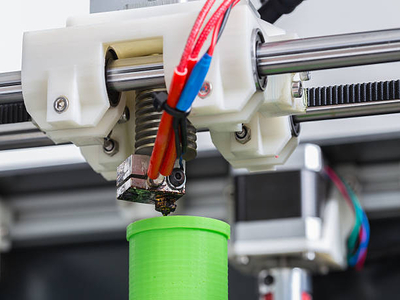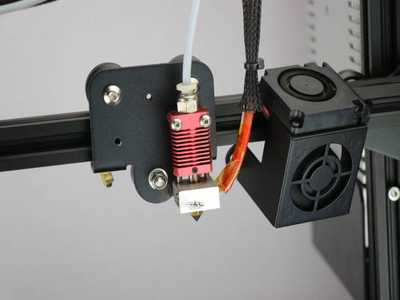What is the extruder on a 3D printer? It’s one of the most important pieces of your 3D printer. Without it, you will not be able to create any 3D prints.
In this post, we’ll discuss the role the 3D printer extruder plays in certain additive manufacturing procedures.
what is the extruder on a 3D printer?

An extruder is critical to your additive manufacturing projects as it is the component of your 3D printer that discharges liquid or semi-liquid material in successive layers.
In some situations, the extruder merely uses a bonding agent to solidify a substance that is originally in powder form.
Different 3D Printing Technologies
SLA Printers
In the case of stereolithography (SLA), raw materials are sent to a heated extruder that works in tandem with 3D Filament Deposition Extruders, distributing molten material across a melting pool.
The extruder is required for the effective operation of machines that utilize Binder Jetting, Polyjet technologies, and even 3D Systems’ CPX systems.
These are additive manufacturing machines that require the deposition of substance before changing its chemical properties (Binder Jetting).
Read our related article on the Best SLA 3D Printer on the market! Here are our favorite picks and why.
FDM printers
The component that extrudes liquid plastic and deposits it on a printing platform in an FDM printer is the filament extruder.
A motor drives the plastic filament while a nozzle (or extruder) controls its flow, and adds successive layers to the printing platform.
As technology advances, two extruders are now standard on some types of FDM 3D printers, allowing you to make two materials at the same time.
This advancement allows you to print in two colors and print support material as your project progress that can be extracted by using a solvent.
Some 3D printers, on the other hand, are enclosed to regulate the plastic cooling procedure.
This helps guarantee a consistent temperature in the manufacturing chamber, resulting in more uniform print results.
Binder Jetting Printers
The most prevalent Binder Jetting printers are most likely 3D Systems’ Project models.
An extruder in this printer projects a bonding agent (or color) onto a powdered substance.
It is the act of projecting this bonding agent on successive layers of powder that results in a 3D object.
Polyjet Printers
Up until recently, Polyjet technology was based on the projection of resin droplets onto a printing platform where the resin is UV polymerized after the droplets are projected.
Read More: PolyJet vs FDM and PolyJet vs SLA. See which is the better 3D printer!
Cold end and hot End Extruders

The cold end is located at the upper part of the 3D printer extruder. At this point, the filament is not being heated and is a crucial element of the 3D printer.
The cold end mixes the melted plastic from the hot end with filament from the spool, pushing it into the tube that runs through the printer.
Different systems do exist, however, they are often made up of gears and hobbed bolts, defining how far the printing filament moves.
The printing process then begins with the extrusion of solid material onto the build plate, which is then heated and melted.
The temperature difference between the hot end, cold filament, and the final cold and solid portion must be closely controlled.
The heat break, in tandem with the heat sink, forms a barrier at which the filament is exposed to high temperatures.
This is done through a heater cartridge that is warm, passing heat to the nozzle via the aluminum heater block
The 3D printer nozzle size found on desktop 3D printers is generally 0.4mm, but there are many more to choose from.
The most popular type of nozzle for 3D printers is made of brass but there are a variety of alternatives available with stainless steel being preferable for certain materials.
Read More: What is a Hot End On a 3D Printer? Learn more about hot ends, including the best options, in this guide!
Direct or Bowden extruder: Which one to choose
When choosing an extruder, there are a few factors to keep in mind when choosing the right one for your project.
Some factors to consider include the type of 3D printer you have, materials you plan to use, printing speed needs, and accuracy desired.
There are two different types of extruders to choose from, Direct and Bowden, but the type of extruder you will need depends on the nature of your job.
All printers feature motors, but geared extruders may be used to regulate printing speed.
It’s not necessary, but it might assist you in customizing your configurations to improve print quality.
Bowden Extruders
A Bowden extruder has a tube that connects the hot end to the extruder body.
The gear then turns by a stepper motor attached directly to the filament feed, allowing for shorter filament paths.
Direct Extruders
Direct extruders are preferable for 3D printing using flexible filaments because they have a shorter filament path and can be produced entirely with a Direct extruder.
Because only the printing head moves instead of the entire extruder hot end, Bowden extruders can produce quicker models as they are simpler to speed up or slow down.
Both extruders have a direct-drive mechanism and the filament drive technology for either extruder option can be placed on the motor shaft directly.
Additionally, keep in mind that there are extruders for all filament thicknesses, including 3mm filament, 1.75mm filament, and so on.
No matter what type of extruder you choose, you will want to calibrate your extruder to avoid some common issues (discussed below).
The following video illustrates why and how you will want to calibrate your extruder:
Read More: Thangs 3D Printing World. This 3D print model search engine opens up thousands of printing possibilities!
Common Issues With Extruders
Three tough printing problems with extruders are:
- Bad maintenance
- Using the incorrect materials that can cause deterioration or clogging of the nozzle that dispenses the material
- Improper cleaning
The main difficulty with 3D printers is that blocked print nozzles prevent the hardened plastic from exiting the extruder, as well as insufficient or misshapen filament extrusion axes.